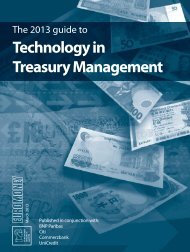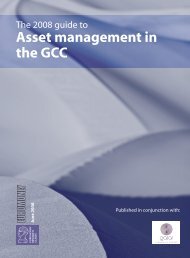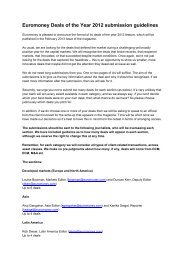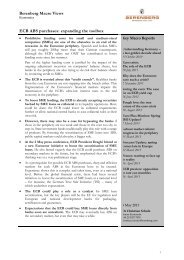Download guide (PDF) - Euromoney
Download guide (PDF) - Euromoney
Download guide (PDF) - Euromoney
You also want an ePaper? Increase the reach of your titles
YUMPU automatically turns print PDFs into web optimized ePapers that Google loves.
The 2012 <strong>guide</strong> to<br />
GLOBAL RISK TRENDS<br />
9<br />
of sovereign credit risk: implications<br />
for financial stability’, in the December<br />
2011 Bank for International Settlements<br />
(BIS) Quarterly Review. The authors<br />
describe how “deterioration in sovereign<br />
creditworthiness drives up banks’ funding<br />
costs and impairs their market access.<br />
Moreover, due to the extensive role of<br />
government securities in the financial<br />
system, banks cannot fully insulate<br />
themselves from higher sovereign risk by<br />
changing their operations.”<br />
With Spain acknowledging it will require<br />
a €100 billion bank bail-out, Italy also<br />
edging toward default, and wider fears over<br />
sovereign debt dynamics as many countries<br />
fail to find the recipe for economic growth,<br />
the health of the region’s financial<br />
system continues to cause alarm. All 17<br />
eurozone sovereigns have succumbed<br />
to increased bank stability risk this year,<br />
perpetuating the trend decline. There is<br />
nonetheless considerable variation among<br />
member states. Spain’s bank stability<br />
10<br />
9<br />
8<br />
7<br />
6<br />
5<br />
4<br />
3<br />
2<br />
1<br />
0<br />
ECR Government Finances Scores (y-axis) vs<br />
Bank Stability Scores (x-axis)<br />
Source: <strong>Euromoney</strong> Country Risk<br />
0 1 2 3 4 5 6 7 8 9 10<br />
Davies and Ng further explain how<br />
deterioration in a ‘home sovereign’ credit<br />
rating - the country in which a bank is<br />
headquartered – is revealed in a rise in<br />
the banks’ credit default spreads (the<br />
cost of insuring against a debt default),<br />
a fall in short-term debt issuance and<br />
a drain on deposits. Four channels<br />
are identified by which sovereign risk<br />
affects banks’ funding: losses on<br />
sovereign holdings, lower collateral<br />
values for wholesale and central bank<br />
funding, reduced funding benefits from<br />
government guarantees and depressed<br />
credit ratings.<br />
score has fallen aggressively, of course,<br />
and it is now the third riskiest banking<br />
system in the region behind Greece and<br />
Ireland. There have also been large falls in<br />
bank stability scores for other eurozone<br />
participants. An erosion of confidence in<br />
the banking systems in Luxembourg and<br />
the Netherlands is particularly noteworthy.<br />
However, both countries can still boast<br />
high scores in comparison with other parts<br />
of the eurozone - especially Luxembourg,<br />
which is considered to have the safest<br />
banking system bar rock-solid Finland, an<br />
indication that it still offers considerable<br />
security for counterparties and deposit-

















